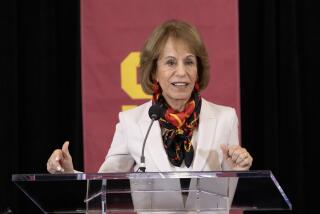Shortage of Presidents Worries Community College Districts
- Share via
The impending retirement of nearly half the nation’s community college presidents over the next four to six years could leave hundreds of campuses rudderless because of a dearth of worthy successors, particularly in Southern California, experts say.
“It’s a crisis,” said David Wolf, executive director of the Accrediting Commission for Community and Junior Colleges. “The [applicant] pools are drying up.”
The Los Angeles Community College District, the largest in the nation with 110,000 students, knows that better than anyone. For all but three of the last 10 years, the district has had at least two temporary campus presidents at a given time. When a new administrator is chosen for West Los Angeles College this year, five of the city’s nine colleges will have brought on new leaders in the last 12 months.
More and more talented educators are avoiding administrative careers because the jobs are all-consuming, recruitment officials say. Many campuses are old and falling apart, there never seems to be enough money, and presidents find themselves spending long hours appeasing unions, politicians and interest groups, officials say. They also note that some out-of-state prospects are hesitant to give up tenure to move to California, where presidents can be fired at will.
Add the increasingly complicated issues of diversity, changing technology and legal battles, recruiters say, and it’s no wonder the average college president is burned out after five years. The result is a leadership vacuum that leaves department heads and instructors without direction and endangers accreditation, officials say.
“When that leadership suffers, so do the students,” said Wolf, a former president of Pierce College in Woodland Hills.
A recent survey conducted by the American Assn. of Community Colleges in Washington shows that roughly 500 of the nation’s 1,100 campus heads will retire by 2007. The study shows there is no pipeline of future administrators.
In California, about 20 presidential searches are underway at any time among the 108 campuses, Community College Chancellor Tom Nussbaum said.
Southwest College in South-Central Los Angeles has not had a permanent president for more than five years. The district started and stopped searches without finding a good match for several reasons, including a high turnover among district chancellors, few applicants and recruiters who are busy hiring for other campuses.
West Los Angeles College has not even begun its search to hire its fourth president in three years. Trade-Tech College near downtown is expected to seat a new president within a month. Both jobs, which pay about $120,000 a year, have been open for about a year.
Because the nine-campus Los Angeles district is so large, it is experiencing the crunch sooner than others across the state, officials say.
“We’re getting in a situation where people staying in their positions only three to five years is not unusual,” Nussbaum said. “Sometimes they’re leaving for better positions. Sometimes they’ve worn out their welcomes or the conditions are too stressful locally.”
Two of the recent hires in Los Angeles came from neighboring districts and a third was a self-employed educational consultant who formerly headed El Paso Community College in Texas.
The district once was dominated by presidents who were trained locally, primarily in graduate programs at UCLA, USC and Pepperdine University. The flow of candidates from those programs has slowed to a trickle, in part because of funding cuts. Now, the University of Texas supplies more college presidents to California than any other institution, according to the survey.
A bill sponsored by state Sen. Jack Scott (D-Altadena) would provide $1.5 million to help pay for a college president training program at Claremont Graduate University. The bill has just come out of committee.
Nussbaum said educators throughout the nation have neglected to prepare the next generation of leadership.
“Now we’re trying to make sure we’re prepared when the heaviest need comes,” he said. “These are very challenging positions, and they’re getting harder to fill.”
The district lost five presidents between 1999 and 2000 by forced or voluntary resignation. Its Board of Trustees hired its fourth chancellor in 10 years.
“My sense was the district was in such poor shape with recession and huge enrollment losses that there was a general fiscal crisis,” board member Mona Fields said. “Somewhere during those years, it became a holding pattern of people retiring, and the district kept putting interim people in. They couldn’t find the right presidents.”
The board is trying to hire presidents who will stay at least five years, although there are no guarantees, Fields said. Nationwide, the average president serves about seven years. In California, presidents last a little more than four years and in the Los Angeles district, barely 2 1/2 years over the past decade.
“All this begs for leadership training and support systems, which are in very poor shape right now,” Wolf said.
(BEGIN TEXT OF INFOBOX / INFOGRAPHIC)
Community College Presidents
Over the past decade, it appears that college presidents have been playing musical chairs in the L.A. Community College District, with some switching from one school to another or returning to previous locations. School-by-school profile:
Source: Los Angeles Community Colleges
More to Read
Sign up for Essential California
The most important California stories and recommendations in your inbox every morning.
You may occasionally receive promotional content from the Los Angeles Times.













